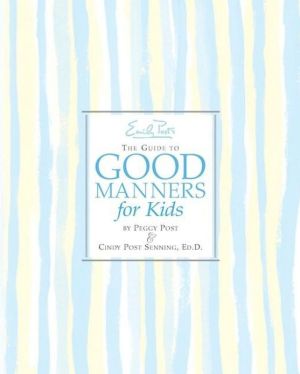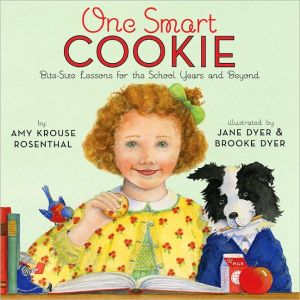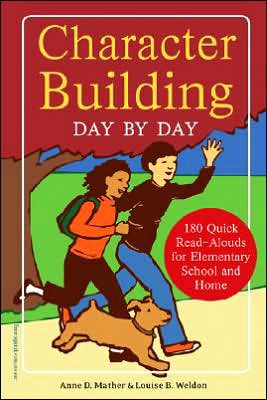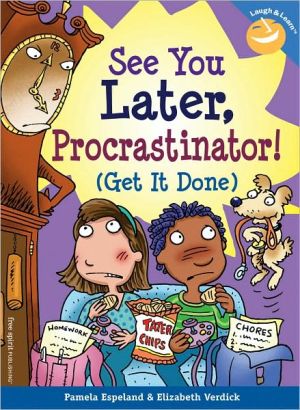Emily Post's The Guide to Good Manners for Kids
Since 1922, the name Emily Post has represented good manners based on kindness, courtesy, and unselfishness. Today, the third generation of Post authors, Peggy Post and Cindy Post Senning, offers the children of the twenty-first century a comprehensive guide to good manners. This book is full of the simple, practical advice that Emily herself would have offered. Written with kids in mind and full of bold illustrations, emily post's the guide to good manners for kids is a reference guide that...
Search in google:
Since 1922, the name Emily Post has represented good manners based on kindness, courtesy, and unselfishness. Today, the third generation of Post authors, Peggy Post and Cindy Post Senning, offers the children of the twenty-first century a comprehensive guide to good manners. This book is full of the simple, practical advice that Emily herself would have offered. Written with kids in mind and full of bold illustrations, emily post's the guide to good manners for kids is a reference guide that children will use and parents can trust. It covers just about every situation a kid will face: writing thank-you notes attending after-school events using the Internet safely speaking — politely — on cell phones participating in weddings helping out at home Emily Post's The Guide to Good Manners for Kids has all the information on etiquette busy children — and busy parents — will need as they go about their daily lives.Publishers WeeklyEmily Post's The Guide to Good Manners for Kids by Peggy Post and Cindy Post Senning (the coauthors are Emily Post's great-granddaughter-in-law and great-granddaughter) offers guidance even adults will appreciate, with age-old advice on attending weddings to contemporary etiquette on cell phone usage. The authors also suggest wording for invitations to a bar mitzvah and bat mitzvah, and explain events such as confirmation and quinceanera ("a Latino girl's fifteenth birthday") and offer ideas for small get-togethers, such as a picnic or slumber party. Pen-and-inks by Steve Bjokman liven up the proceedings. Copyright 2004 Reed Business Information.
\ From Barnes & NobleThe Barnes & Noble Review\ Whether she was educating us about table settings or proper greetings for formal occasions, Emily Post made a name for herself by teaching manners to legions of readers. Since Emily's demise, her descendents have picked up the torch; and now, at the start of the 21st century, Peggy Post and Cindy Post Senning aim their etiquette advice at kids. In chapters that focus on different areas of a child's life -- home, school, recreation, going out, and more -- the authors detail what manners to always remember and how to navigate potentially awkward situations. Wondering how to behave at a concert? Post and Senning give great pointers. What if your sister is the star of the show? The authors show how to handle that scenario with equal finesse. Whether kids are seeking advice about dealing with divorce, using cell phones in public, or choosing bunks at camp, this guide will steer them in the right direction with its straightforward language and sage wisdom. And with a smart introduction from the authors (and even a chapter on special religious and social events like weddings and quinceañeras), this handy reference will help incorporate children into a well-mannered society that would make Emily Post proud. Shana Taylor\ \ \ \ \ Publishers WeeklyEmily Post's The Guide to Good Manners for Kids by Peggy Post and Cindy Post Senning (the coauthors are Emily Post's great-granddaughter-in-law and great-granddaughter) offers guidance even adults will appreciate, with age-old advice on attending weddings to contemporary etiquette on cell phone usage. The authors also suggest wording for invitations to a bar mitzvah and bat mitzvah, and explain events such as confirmation and quinceanera ("a Latino girl's fifteenth birthday") and offer ideas for small get-togethers, such as a picnic or slumber party. Pen-and-inks by Steve Bjokman liven up the proceedings. Copyright 2004 Reed Business Information.\ \ \ Children's LiteratureEtiquette for children and teenagers is the subject of this great book that deserves to be promoted by libraries, bookstores and parents. It is easy to identify what needs to be learned through the chapter divisions. They are "Everyday Life," "At Home," "At School," "At Play," "Out and About," "On the Go," "Away From Home," and "Other Special Occasions." There is also an index. The introduction should not be overlooked either. The subtopics within the chapters help readers quickly find the material of interest. There are sidebars that give further detail or insight. There are black and-white drawings that emphasize a point. It is all quite good. A bonus is the compilation of relatively hard to find material, such as "Coming-of-Age Celebrations," The "Techno-Manners" and "Online Etiquette" which are certainly relevant today. My favorite is "Camp Havagreatime" because those experiences can be great or they can be terrible. This book would be a wonderful gift or a valuable contribution to libraries of all kinds. A suggestion that I would have, even though I love the colors on the cover, is that it should have a touch of masculinity so that boys know it is for them too! The authors are directors of the Emily Post Institute, Inc. 2004, HarperCollins Publishers, Ages 8 to 12. \ —Naomi Butler\ \ \ \ \ School Library JournalGr 3-7-Post and Senning pinpoint the three main factors in etiquette as respect, consideration, and honesty. The book begins with a chapter on everyday life, which consists of thank yous and other written and spoken words, privacy, greetings and introductions, and techno-manners. The treatment of chat rooms, message boards, e-mail, pagers, and computers offers guidelines that protect users while facilitating positive, healthy interactions. Subsequent chapters take on family relations within the home, situations at school, social events, manners at the mall and concerts, hospital visits, religious events and weddings, and travel. Eating out, whether fast food or fine dining, is covered, as are funerals, taxis, and interacting with a person with a disability. The writing is clear, friendly, and sometimes clever, putting readers at ease and raising myriad possibilities through the use of "what if" scenarios, complete with possible dialogue and even multiple-choice answers. Lists of "Always and Nevers" provide quick reference for things like taking messages, making introductions, and borrowing personal items. "Sticky Situations" offers solutions to avoid embarrassment. The advice is consistently practical and simple, and is addressed to boys as well as girls ("Always put the toilet seat down"). Divorce or remarriage is treated compassionately, with specific suggestions for reacting honestly and considerately toward all parties. Simple sketch drawings adorn the text sporadically, offering humor but no additional information. A fine update to Elizabeth James and Carol Barkin's Social Smarts: Manners for Today's Kids (Clarion, 1996).-Joyce Adams Burner, Hillcrest Library, Prairie Village, KS Copyright 2004 Reed Business Information.\ \







